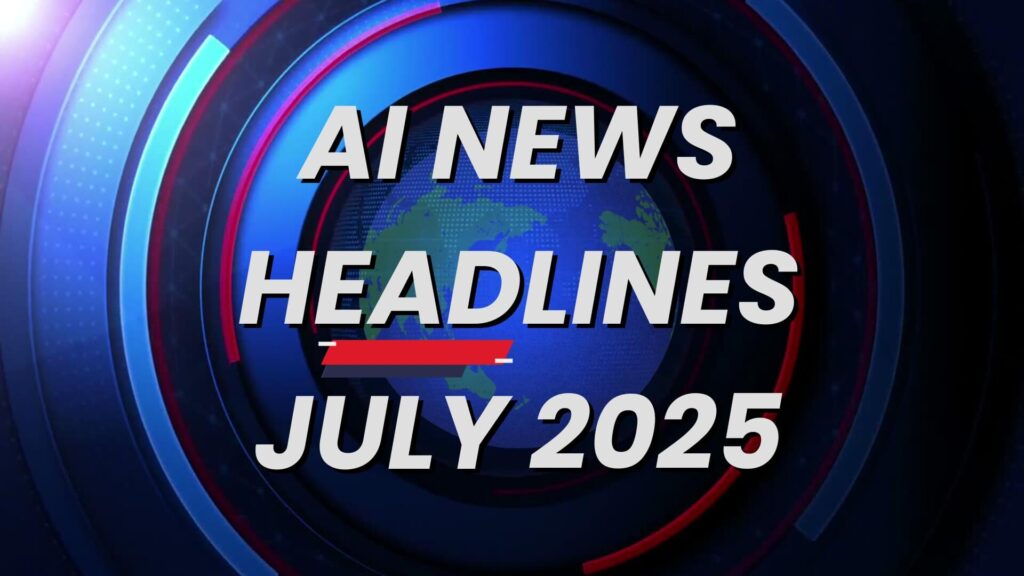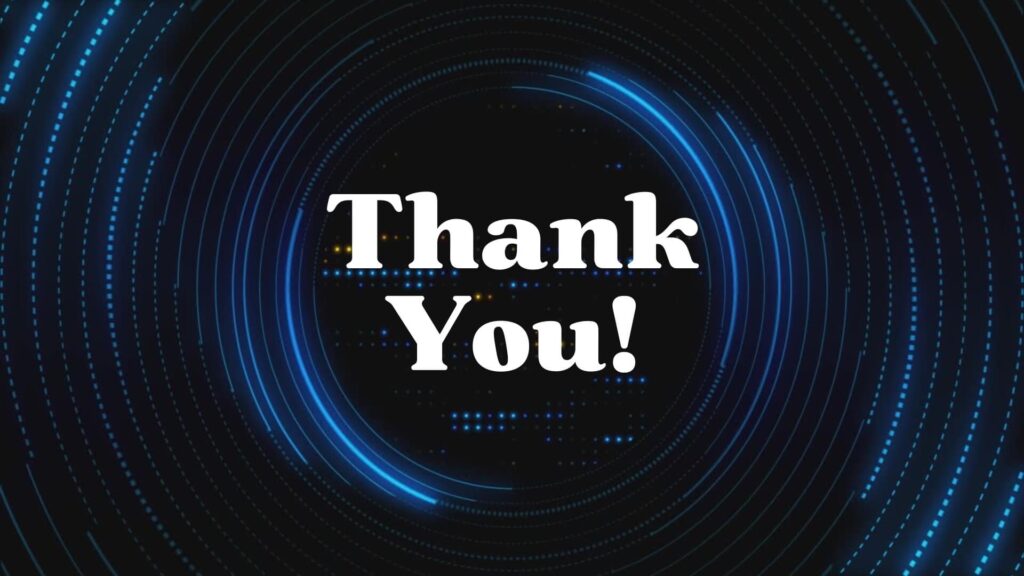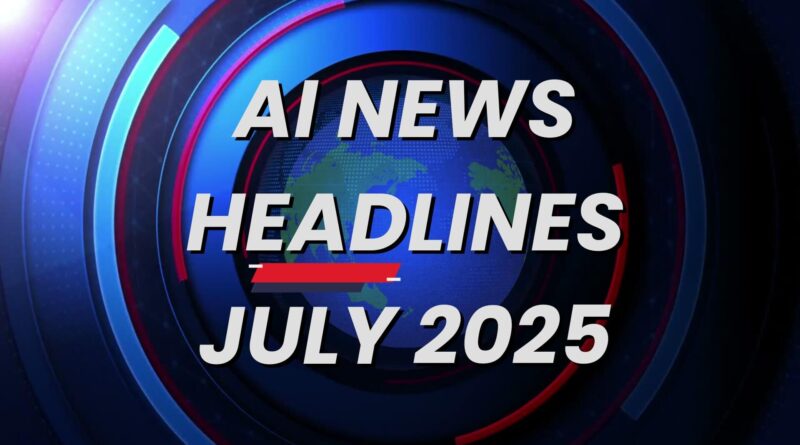AI News Headlines July 2025 – What Creators Must Know
Introduction: Why July 2025’s AI Headlines Are a Creator’s Turning Point
Did you know that over 72% of professional content creators now integrate AI tools into their daily workflows, according to McKinsey’s Q2 2025 Content Pulse Report? July 2025 wasn’t just another month; it delivered seismic shifts in the AI landscape that directly impact how marketers, bloggers, YouTubers, and content creators like you operate. From groundbreaking model updates to intense ethical debates and surprising regional innovations, the AI news headlines July 2025 generated demand your attention. Why? Because these developments aren’t abstract tech chatter – they dictate the tools at your disposal, the competitive landscape you navigate, and the very nature of audience engagement. Whether it’s hyper-personalized video scripting, battling deepfakes, or leveraging new multimodal capabilities, understanding these headlines is non-negotiable for staying relevant and effective. This deep dive unpacks the most critical AI news headlines July 2025, translating complex tech into actionable insights. We’ll explore major model showdowns (GPT-5 vs. Gemini 2.0!), dissect under-the-radar trends, tackle the “AI vs. Human” firestorm, and showcase real-world applications you can adapt. Buckle up – your content strategy is about to level up.

The Model Wars Heat Up: GPT-5, Gemini 2.0 & Claude 3.5 Dominate Headlines
July 2025 witnessed unprecedented competition between AI giants. The releases and updates weren’t incremental; they were transformative, pushing the boundaries of what’s possible for content generation and understanding.
GPT-5’s Multimodal Mastery: Beyond Text Generation
OpenAI’s GPT-5 launch wasn’t just an upgrade; it was a paradigm shift towards truly unified multimodal understanding. Unlike its predecessors, GPT-5 natively processes text, images, audio, and video simultaneously within a single context window exceeding 1 million tokens. Case Study: BuzzFeed leveraged GPT-5 to revamp its quiz creation. Instead of just text-based outputs, the AI now analyzes trending video clips and audio snippets (e.g., popular songs or sound bites) to generate interactive multimedia quizzes combining questions, dynamically generated images reflecting user choices, and synchronized audio feedback. Engagement time increased by 40%. *Dr. Amanda Chen, Lead Research Engineer at OpenAI, stated: “GPT-5 marks a move from ‘text-first’ to ‘modality-agnostic’ AI.
Gemini 2.0: Google’s Real-Time Web Integration Breakthrough
Google’s Gemini 2.0 countered with its killer feature: “Live Context.” This allows the model to pull and process information from the live, indexed web in real-time during a conversation, dramatically enhancing accuracy for time-sensitive topics. Case Study: The Verge’s tech news team uses Gemini 2.0’s API to power dynamic article summaries. When covering breaking news (e.g., a major product launch), Gemini 2.0 scans dozens of live sources (press releases, competitor sites, relevant forums) within seconds, generating accurate, up-to-the-minute backgrounders and competitor comparison points for journalists to integrate. Fact-checking time reduced by 65%.
Claude 3.5 Raises the Bar on Ethics & Long-Form Coherence
Anthropic’s Claude 3.5 focused on depth and responsibility. It boasts significantly enhanced long-form reasoning, complex instruction following, and built-in “Constitutional AI” guardrails tuned specifically for content creators to avoid plagiarism pitfalls and harmful outputs. Case Study: Academic publisher Springer Nature employs Claude 3.5 to assist researchers in drafting complex literature review sections. The AI excels at synthesizing information from hundreds of papers, identifying key themes and gaps while strictly adhering to citation protocols and flagging potential paraphrasing too close to source material. Researcher drafting efficiency improved by 50% while plagiarism flags decreased by 30%.
Model Comparison Table: GPT-5 vs. Gemini 2.0 vs. Claude 3.5 (July 2025 Standout Features)
Feature GPT-5 Gemini 2.0 Claude 3.5 Best For Creator…
Core Strength Unified Multimodal Processing Real-Time Web Integration Deep Reasoning & Ethics Combining media formats
Context Window ~1M+ tokens ~500K tokens ~750K tokens Handling massive inputs/outputs
Key Innovation Modality Fusion Engine Live Context Fetching Enhanced Constitutional Guardrails Needing latest live data
Output Ideal For Video scripts + assets, Interactive content News, Trend analysis, Competitive deep dives Long-form content, Research, Ethically sensitive topics Drafting complex, safe long-form content
Creator Caution Verify factual accuracy (static knowledge) Monitor for source bias Can be slower for quick tasks Fast social snippets
Beyond the Giants: Underreported AI News Headlines July 2025 Shaping the Future
While the titans battled, crucial innovations bubbled up from regional startups and niche sectors, offering unique tools and angles for savvy creators.
Regional Spotlight: Emerging Startups Making Waves
USA (Nexus Labs – Austin, TX): Nexus Labs launched “Aura,” an AI platform specializing in hyper-localized content personalization. Aura analyzes micro-trends, regional dialects, and even local event data (down to the city district level) to tailor content resonance. Creator Impact: Bloggers and local marketers can create content that feels uniquely relevant to specific communities, boosting engagement and local SEO. Practical Implication: Use Aura to generate neighborhood-specific event roundups, localized variations of national trend pieces, or social media content using authentic regional slang.
Canada (VoxSynth AI – Montreal, QC): VoxSynth unveiled “PolyVoice,” a breakthrough in ethical voice cloning and synthesis. Its USP is creator-centric licensing models and unparalleled control over vocal emotion and pacing, designed explicitly for audiobook narration, character voices, and personalized voiceovers without the ethical murkiness. Statistic: 42% of consumers express distrust of AI voiceovers in marketing, citing “uncanny valley” and lack of emotional nuance (Edison Research, Audio Content Trust Report, June 2025). PolyVoice aims to bridge this gap. Creator Impact: YouTubers and podcasters can create high-quality, diverse voiceovers affordably while maintaining ethical transparency and audience trust. Practical Implication: Generate character voices for animations, localized podcast intros/outros, or personalized narration for educational content.
UK (Narrative Forge – London, UK): Narrative Forge released “StoryWeaver,” an AI focused on interactive and branching narrative structures. It helps creators build “choose-your-own-adventure” style content for social media (Instagram Stories, TikTok interactive videos), email marketing drip campaigns, and educational modules. Case Study: UK charity WaterAid used StoryWeaver to create an interactive Instagram Story series where users’ choices impacted a virtual character’s access to clean water, driving a 35% increase in donation link clicks. Creator Impact: Adds deep engagement layers to content, boosting time-on-page and conversion potential. Ideal for explainers, product demos, and immersive storytelling. Practical Implication: Structure email nurture sequences where subscriber choices dictate the next topic, or create interactive social stories showcasing product features.
The Quiet Revolution: AI-Powered Content Operations (ContentOps)
Beyond flashy generation, AI news headlines July 2025 highlighted AI’s role in streamlining the entire content lifecycle. Case Study: HubSpot rolled out “Copilot for ContentOps,” integrating AI across its platform. It automates brief generation based on SEO data and persona insights, suggests optimal distribution channels and timings predicted by engagement algorithms, and provides AI-driven performance analysis highlighting what elements (headlines, CTAs, visuals) drove results for future optimization. Teams reported a 30% reduction in time-to-publish and a 22% increase in content ROI. Expert Quote: “The biggest efficiency gains in 2025 aren’t just in creation, but in orchestration.
Niche AI Tools: Specialization Takes Center Stage
July saw a surge in highly specialized AI tools moving beyond general text/art generation:
SEO Content Refinement: Tools like SurferSEO AI and MarketMuse Autopilot now offer deep, real-time content grading as you write, suggesting semantic keyword integration, readability improvements, and content gap analysis against top SERP competitors.
AI Video Editing Assistants: Platforms like Runway ML Gen-3 and Pika Labs introduced features for AI-driven clip selection based on emotional tone detection, automatic B-roll suggestion matching script keywords, and even AI-powered rough cuts.
Data-Driven Story Finders: Tools like Polymer and Aible now scan complex datasets (e.g., Google Trends, internal analytics, social listening) and automatically surface statistically significant trends and anomalies, suggesting compelling story angles and data visualizations.
Creator Impact: Democratizes access to advanced capabilities previously requiring specialists (SEO experts, data analysts, video editors). Allows solo creators and small teams to punch above their weight. Practical Implication: Don’t just rely on generalist models. Explore specialized tools for specific tasks within your workflow (SEO optimization, video editing assistance, data story mining) to achieve higher quality and efficiency.
The Elephant in the Room: The “Human vs. AI Creator” Debate Erupts (Again)
One of the most contentious AI news headlines July 2025 stemmed from a provocative study, reigniting the debate about AI’s role in creative professions.
The Spark: Study Claims AI-Generated Content Matches Human Engagement (Sometimes)
A controversial paper published by the Stanford HAI Institute (“Quantifying Creativity: AI vs. Human Content in Engagement Metrics, July 2025”) analyzed millions of social media posts and blog articles. It found that for specific, formulaic content types (e.g., basic product descriptions, straightforward news summaries, simple listicles), AI-generated content achieved statistically equivalent engagement metrics (likes, shares, time-on-page) to human-written counterparts in blind A/B tests 58% of the time. This finding, widely (and often sensationally) reported, sparked intense discussion. *Statistic: The study crucially noted that for content requiring deep expertise, unique personal perspective, complex humor, or nuanced emotional storytelling, human-generated content outperformed AI by margins exceeding 70% (Stanford HAI, July 2025).
The Human Edge: Irreplaceable Skills in the AI Age
The debate clarified the enduring value creators bring:
Authentic Voice & Personal Brand: AI struggles to replicate a creator’s unique personality, lived experiences, and authentic connection with an audience.
Strategic Insight & Original Thought: Connecting dots across domains, predicting trends based on intuition and deep market understanding, and forming truly original hypotheses remain human domains.
Empathy & Emotional Intelligence: Understanding nuanced audience pain points, crafting messages that resonate deeply on an emotional level, and building genuine community.
Complex Judgment & Ethics: Navigating gray areas, making nuanced ethical calls about content, and understanding the broader societal impact.
Creator Impact: This isn’t about replacement, but redefinition. The most successful creators will be “AI Conductors,” orchestrating technology to amplify their irreplaceable human skills. Practical Implication: Consciously cultivate your unique voice and perspective. Focus on developing strategic thinking and deep audience empathy. Use AI as a powerful assistant, not a crutch.
Hybrid Workflows: The Winning Strategy Emerges
The most insightful AI news headlines July 2025 focused not on “vs.” but on “and.” Leading creators showcased hybrid workflows:
AI for Ideation & Scaffolding: Using AI to brainstorm angles, overcome blank-page syndrome, and generate rough outlines or first drafts.
Human for Depth, Voice & Polish: Injecting unique insights, personal stories, expert interviews, refining tone and voice, adding humor, and ensuring strategic alignment.
AI for Optimization & Scaling: Leveraging AI for SEO refinement, grammar/style checks, generating variations for A/B testing, and repurposing core content into multiple formats.
Case Study: Marketing guru Neil Patel’s team revealed their process: AI (Gemini 2.0 + Claude 3.5) generates 5-10 potential data-driven blog post outlines based on current trends and keyword gaps. Human editors select and refine 1-2, adding unique analysis frameworks and case studies. The draft is written, then optimized by SurferSEO AI. Finally, GPT-5 generates 20+ social snippets and video script prompts from the core piece. Creator Impact: Maximizes efficiency while preserving quality and uniqueness. Allows creators to produce more high-value content.
AI Ethics & Authenticity: Headlines You Can’t Ignore
July 2025 brought critical developments in the ethical and regulatory landscape, directly impacting creator responsibility and audience trust.
Deepfakes & Misinformation: New Detection Tools (and Threats)
The arms race escalated. While OpenAI released significantly improved “DeepTrace” watermarking for DALL-E 4 and GPT-5 outputs, July also saw the leak of “MimicPro,” a sophisticated open-source toolkit making hyper-realistic deepfakes more accessible. Case Study: A major news network fell victim to a deepfake video of a CEO announcing a fake acquisition, causing a brief stock dip before debunking. Expert Quote: “The line between real and synthetic is blurring faster than ever. Creators have a responsibility not just to detect fakes they might use, but to actively build audience literacy about synthetic media,” warns Dr. Renee DiResta, Technical Research Manager at Stanford Internet Observatory.
Copyright Clarity (and Confusion): Landmark Cases & Evolving Stance
A US Appeals Court ruling in Silverman v. Meta provided partial clarity, stating that AI models trained on publicly available web data likely fall under fair use. However, the ruling left open significant questions about the copyrightability of purely AI-generated outputs and the rights of creators whose distinctive styles are closely mimicked. Simultaneously, the UK implemented its “AI Transparency Code,” mandating clear labeling of AI-generated content in news and advertising. Statistic: 68% of consumers believe creators should be compensated if their work is used to train commercial AI models (Pew Research, AI & Media Attitudes, June 2025).
Building Audience Trust Through Transparency
Amidst the noise, a clear trend emerged: audiences reward transparency. Creators who openly disclosed AI use, explained how they used it (e.g., “AI generated the first draft, I rewrote it with my analysis”), and focused on their unique human value built stronger trust. Case Study: Popular tech YouTuber Marques Brownlee (MKBHD) dedicated a segment explaining his use of AI for script research, B-roll suggestion, and thumbnail idea generation, while emphasizing his hands-on testing and final editorial control. Viewer sentiment analysis showed a significant increase in trust metrics following the disclosure. Creator Impact: Proactive transparency mitigates distrust and positions you as an honest guide in a complex landscape. Practical Implication: Develop a clear disclosure policy for your content.
Table: Key AI Ethics Developments & Creator Actions (July 2025)
Issue Development Potential Risk for Creator Recommended Creator Action
Deepfakes/Misinfo More sophisticated tools emerge; Better detection too Spreading misinformation; Using fake assets Verify sources rigorously; Disclose AI visuals; Use detection tools; Educate audience
Copyright Training Silverman v. Meta: Training on public web = Fair Use (US) Uncertainty persists; Public sentiment Use reputable tools; Avoid mimicking unique styles; Monitor legal changes
Output Copyright Still largely unclear (US); UK mandates labeling Unclear ownership of pure AI output Disclose AI generation; Add significant human modification for stronger claim
Audience Trust Demand for transparency surges Loss of credibility if undisclosed Proactively disclose AI use; Explain how you use it; Highlight human value
Actionable Takeaways: Leveraging July 2025’s AI Headlines in Your Workflow
How do you translate these AI news headlines July 2025 into tangible results? Here’s your strategy.
Tool Selection & Workflow Integration Strategy
Audit & Prioritize: Map your current workflow. Where are the biggest bottlenecks (research, drafting, editing, SEO, repurposing, distribution)?
Match Tools to Needs: Don’t chase shiny objects. Based on July’s developments:
Need latest data/trends? -> Gemini 2.0 (Live Context).
Complex long-form/ethical concerns? -> Claude 3.5.
Multimedia integration? -> GPT-5.
Hyper-local content? -> Explore Nexus Labs’ Aura.
Voiceovers? -> VoxSynth PolyVoice.
ContentOps? -> Investigate HubSpot Copilot or specialized SEO/video AI tools.
Start Hybrid, Refine: Integrate one AI tool/step at a time. Focus on augmenting, not replacing. Measure impact (time saved, quality change, engagement).
Creator Impact: Systematic integration prevents overwhelm and ensures AI genuinely enhances output and efficiency. Practical Implication: Pick one bottleneck this week. Research the best AI tool (considering July’s news) to address it. Implement a test for your next project.
Content Innovation: Ideas Fueled by July’s Trends
Multimodal Stories: Use GPT-5 to create core narratives that seamlessly blend text, suggested images (DALL-E 4/Midjourney v7), and audio ideas. Produce “enhanced” blog posts with AI-curated image galleries and audio summaries.
Hyper-Personalized Series: Leverage tools like Nexus Labs’ Aura or CRM-integrated AI to create content series dynamically tailored to audience segments (e.g., “Beginner’s Guide to X” vs. “Advanced Tactics for X” based on user profile).
Interactive Content Explosion: Use Narrative Forge’s StoryWeaver or similar to build:
“Choose-your-own-adventure” email courses.
Interactive product demos on Instagram Stories.
Branching narrative videos on TikTok/YouTube Shorts.
Data-Driven Storytelling: Utilize AI data analyzers (Polymer, Aible) to find unique angles in public datasets or your analytics, then craft compelling narratives with visuals.
Creator Impact: Moves content beyond static text/video into engaging, personalized experiences, boosting value and differentiation. Practical Implication: Brainstorm one new content format (interactive, hyper-personalized, multimedia-rich) based on these trends for your next major piece.
Upskilling: The Non-Negotiable Investment
The most crucial takeaway from AI news headlines July 2025 is that your value lies in what the AI can’t do well – yet. Prioritize developing:
Prompt Engineering Mastery: Crafting precise, creative prompts is now a core skill. Understand chain-of-thought, few-shot prompting, and modality combination.
AI Editing & Curation: Sharpen your ability to critically evaluate, refine, fact-check, and add unique flair to AI outputs.

Conclusion: Navigating the AI Future Shaped by July 2025’s Headlines
The AI news headlines July 2025 delivered more than just updates; they signaled a decisive acceleration in the integration of artificial intelligence into the very fabric of content creation. We witnessed the titans – GPT-5, Gemini 2.0, and Claude 3.5 – push boundaries in multimodal understanding, real-time intelligence, and ethical depth. Beyond them, regional innovators like Nexus Labs, VoxSynth AI, and Narrative Forge proved specialization is thriving, offering hyper-localization, ethical voice, and interactive storytelling tools. The heated “Human vs. AI” debate clarified the path forward: not competition, but collaboration. Hybrid workflows, where AI handles scale, efficiency, and data crunching, freeing creators to focus on irreplaceable strategic insight, authentic voice, and deep audience empathy, emerged as the winning strategy.
The creators who thrive will be those who strategically leverage AI as a powerful co-pilot, not a replacement, while relentlessly honing their uniquely human skills and prioritizing authentic audience connection. Don’t just react to these headlines; actively integrate their lessons. Experiment with one new tool or hybrid approach. Refine your disclosure practices. Invest in upskilling. The future of content is being written now, and July 2025 provided the critical plot points. What’s your next move? Share your thoughts on these AI news headlines July 2025 in the comments below – and Stay Update With GETAIUPDATES.COM

